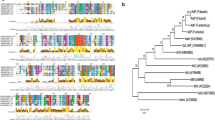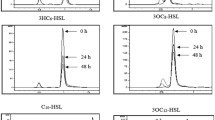Abstract
A bacterial strain, KM1S, was isolated from a Malaysian rainforest soil sample by using a defined enrichment medium that specifically facilitates selection of quorum quenching bacteria. KM1S was clustered closely to Bacillus cereus by 16S ribosomal DNA sequence analysis. It degraded N-3-oxo-hexanoyl homoserine lactone and N-3-oxo-octanoyl homoserine lactone in vitro rapidly at 4.98 and 6.56 μg AHL h−1 per 109 CFU/ml, respectively, as determined by the Rapid Resolution Liquid Chromatography. The aiiA homologue, encoding an autoinducer inactivation enzyme catalyzing the degradation of N-acylhomoserine lactones, of KM1S was amplified and cloned. Sequence analysis indicated the presence of the motif 106HXDH-59 amino acids-H169-21 amino acids-D191 for N-acylhomoserine lactone lactonases.





Similar content being viewed by others
References
Cámara M, Williams P, Hardman A (2002) Controlling infection by tuning in and turning down the volume of bacterial small-talk. Lancet Infect Dis 2:667–676
Chan KG, Tiew SZ, Ng CC (2007) Rapid isolation method of soil bacilli and screening of their quorum quenching activity. Asia Pac J Mol Biol Biotechnol 15:153–156
Chan KG, Yin WF, Sam CK, Koh CL (2009) A novel medium for the isolation of N-acylhomoserine lactone-degrading bacteria. J Ind Microbiol Biotechnol 36:247–251
De Kievit TR, Iglewski BH (2000) Bacterial quorum sensing in pathogenic relationships. Infect Immun 68:4839–4849
Dong YH, Xu JL, Li XZ, Zhang LH (2000) AiiA, an enzyme that inactivates the acylhomoserine lactone quorum sensing signal and attenuates the virulence of Erwinia carotovora. Proc Natl Acad Sci USA 97:3526–3531
Dong YH, Gusti AR, Zhang Q, Xu JL, Zhang LH (2002) Identification of quorum quenching N-acyl homoserine lactonases from Bacillus species. Appl Environ Microbiol 68:1754–1759
Dong YH, Zhang XF, Xu JL, Zhang LH (2004) Insecticidal Bacillus thuringiensis silences Erwinia carotovora virulence by a new form of microbial antagonism, signal interference. Appl Environ Microbiol 70:954–960
Flagan S, Ching WK, Leadbetter JR (2003) Arthrobacter strain VAI-A utilizes acyl-homoserine lactone inactivation products and stimulates quorum signal biodegradation by Variovorax paradoxus. Appl Environ Microbiol 69:909–916
Kaufmann GF, Sartorio R, Lee SH, Rogers CJ, Meijler MM, Moss JA, Bruce C, Andrew PB, Tobin JD, Kim DJ (2005) Revisiting quorum sensing: discovery of additional chemical and biological functions for 3-oxo-N-acylhomoserine lactones. Proc Natl Acad Sci USA 102:309–314
Lane DJ, Pace B, Olsen GJ, Stahl DA, Sogin ML, Pace NR (1985) Rapid determination of 16S ribosomal RNA sequences for phylogenetic analyzes. Proc Natl Acad Sci USA 82:6955–6959
Lin YH, Xu JL, Hu JY, Wang LH, Ong SL, Leadbetter JR, Zhang LH (2003) Acyl-homoserine lactone acylase from Ralstonia strain XJ12B represents a novel and potent class of quorum-quenching enzymes. Mol Microbiol 47:849–860
McClean KH, Winson MK, Fish L, Taylor A, Chhabra SR, Cámara M, Daykin M, Lamb JH, Swift S, Bycroft BW, Stewart GSAB, Williams P (1997) Quorum sensing and Chromobacterium violaceum: exploitation of violacein production and inhibition for the detection of N-acylhomoserine lactones. Microbiology 143:3703–3711
Miller MB, Bassler BL (2001) Quorum sensing in bacteria. Annu Rev Microbiol 55:165–199
Sambrook J, Fritsch EF, Maniatis T (1989) Molecular cloning: a laboratory manual, 2nd edn. Cold Spring Harbor Laboratory, USA
Swift S, Winson MK, Chan PF, Bainton NJ, Birdsall M, Reeves PJ, Chhabra SR, Hill PJ, Throup JP, Bycroft BW, Salmond GPC, Williams P, Stewart GSAB (1993) A novel strategy for the isolation of LuxI homologs: evidence for the widespread distribution of a LuxR:LuxI superfamily in enteric bacteria. Mol Microbiol 10:511–520
Williams P (2002) Quorum sensing: an emerging target for antibacterial chemotherapy? Expert Opin Ther Targets 6:1–8
Winson MK, Swift S, Fish L, Throup JP, Jorgensen F, Chhabra SR, Bycroft BW, Williams P, Stewart GSAB (1998) Construction and analysis of luxCDABE-based plasmid sensors for investigating N-acyl homoserine lactone-mediated quorum sensing. FEMS Microbiol Lett 163:185–192
Yates EA, Philipp B, Buckley C, Atkinson S, Chhabra SR, Sockett RE, Goldner M, Dessaux Y, Cámara M, Smith H, Williams P (2002) N-acylhomoserine Lactones undergo lactonolysis in a pH-, temperature-, and acyl chain length-dependent manner during growth of Yersinia pseudotuberculosis and Pseudomonas aeruginosa. Infect Immun 70:5635–5646
Acknowledgements
We gratefully acknowledge the support of three grants from the University of Malaya, namely, Vot F Research Grant (FS260/2008C), Research University Grants (TA048-2008A, RG003/09BIO), both to KG Chan, and Postgraduate Research Grant (PS256/2008A) to CS Wong.
Author information
Authors and Affiliations
Corresponding author
Electronic supplementary material
Below is the link to the electronic supplementary material.
Rights and permissions
About this article
Cite this article
Chan, KG., Wong, CS., Yin, WF. et al. Rapid degradation of N-3-oxo-acylhomoserine lactones by a Bacillus cereus isolate from Malaysian rainforest soil. Antonie van Leeuwenhoek 98, 299–305 (2010). https://doi.org/10.1007/s10482-010-9438-0
Received:
Accepted:
Published:
Issue Date:
DOI: https://doi.org/10.1007/s10482-010-9438-0




